Do you know the colorful flower-like structures that can be found everywhere under the bottom of the sea? They are called sea anemones. They have soft bodies and are primarily sedentary marine animals. There are many types of sea anemones and we are going to read about one such beautiful type. I invite you all to read the article and get to know all the interesting facts about Bubble Tip Anemone.
The Bubble Tip Anemone is a saltwater aquarium species. It is one of the easiest sea anemones to keep. But it needs basic supplements such as water, lightning and feeding parameters. They are more colorful than other long tentacle anemones. Anemones are less predatory than the other anemones and can propagate relatively easily. They are more prone to the host clownfish.
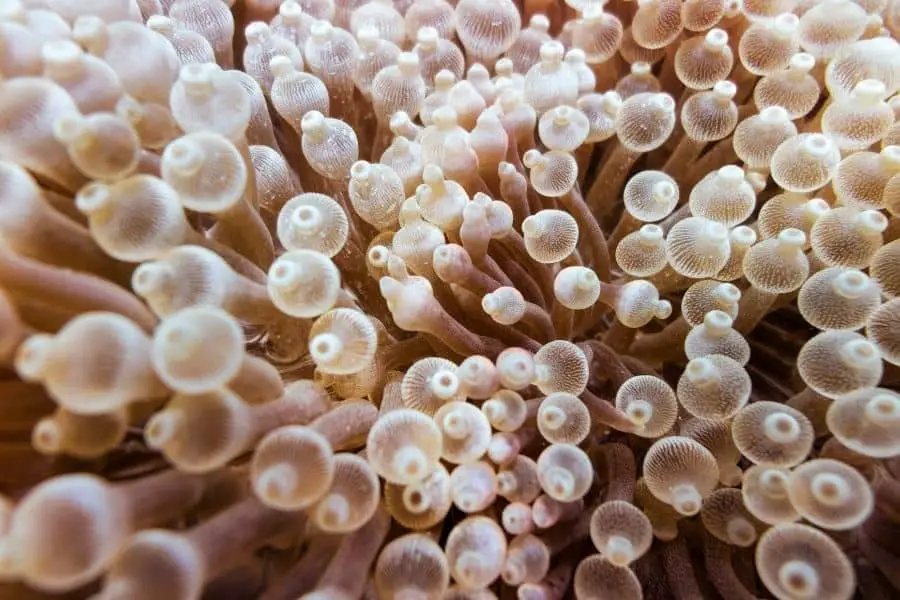
One look Care Guide
Jump To
- 1 One look Care Guide
- 2 tips to identify bubble tips anemone
- 3 different types of Bubble tip anemones
- 4 Tank requirements
- 5 How to place a bubble tip anemone in a tank
- 6 How to frag/propagate them
- 7 How fast do bubble tips anemone grow?
- 8 What do bubble tips anemone eat?
- 9 Bubble tip anemone and clown fish
- 10 Predators of bubble tips anemone
- 11 Why are bubble tip anemone dying?
- 12 Related topics
| Scientific name | Entacmaea quadricolor |
| Common name | Bubble tentacle sea anemone, Bulb tentacle anemone, Babula |
| Care level | Moderate to high |
| Native to | Fiji, Singapore, Indonesia, Philippines, Tonga, and Vietnam |
| Type (soft or hard coral) | Soft coral |
| Color | Variety of colors, commonly green and pink |
| Preferred temperature | 25-28 °C (77° F -82.4 °F) |
| Preferred salinity | 1.023 – 1.025 |
| Growth rate | 4 inches per month |
| Temperament | Semi-aggressive |
| Recommended tank mates | Clownfish, Anemone Shrimp |
| Preferred food | Protein-rich sea foods, chopped fish, squid, shrimp, clams, worms, and mussels |
| Feeding frequency | 1-3 times per week |
| Propagation by | Sexually or asexually. Asexual methods- fragmentation, fission, budding |
tips to identify bubble tips anemone
These anemones are one of the most attractive anemone species. They have soft, polyp-like bodies. They are in a range of colors. Most commonly They are green and pink in color. There are slender and flexible organs present near the mouth of the anemones. They are called tentacles. Tentacles occur in one or more pairs. They are used for grasping and feeding purposes. There are bubbles-like formations at the end of the tip of their tentacles. That is why these anemones are called bubble tip anemones. They can grow in size up to 30 cm (12 inches) long. They are native to Fiji, Singapore, Indonesia, Philippines, Tonga, and Vietnam
different types of Bubble tip anemones
Green Bubble Tip Anemone
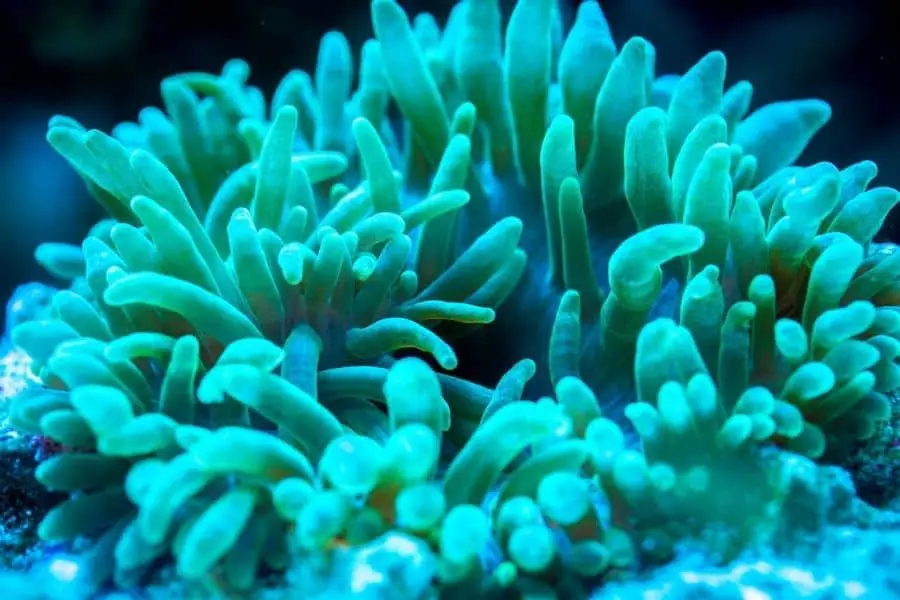
They got green-colored bubbles at the tip of their tentacles. They need strong illumination to keep bright coloration and bulb tips. If the lightning is not enough, they will expand their bodies to get the maximum amount of available sunlight. As a result of receiving insufficient sunlight, their tentacles may appear like rings.
This condition may also develop due to the lack of food. Therefore, enough food should be given to the green anemones. Chopped fish, shrimp, or worms are their diet for them. They should be kept with clownfish. The reason for this is sea clownfish can help anemones to catch their prey.
Rose Bubble Tip Anemone
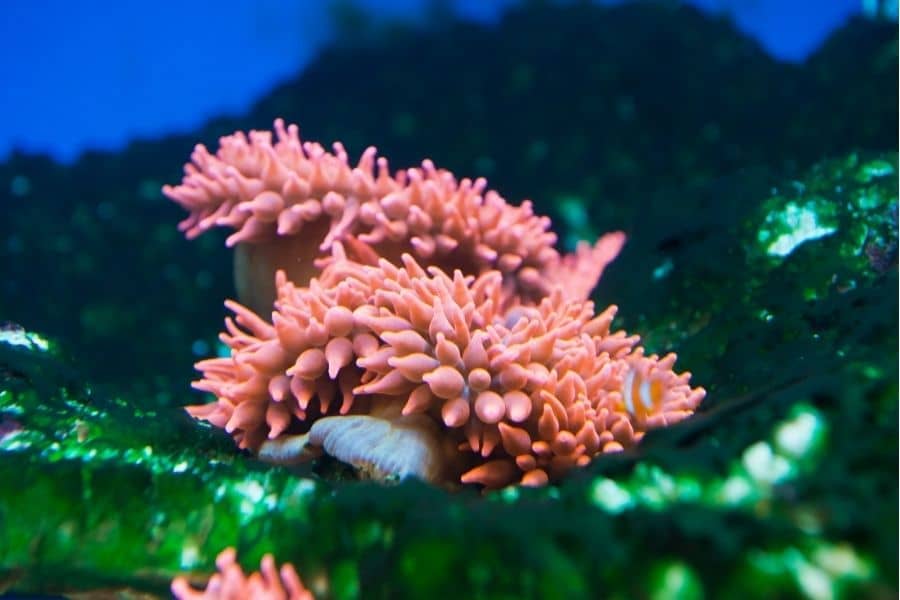
They are a rare color variety of the Bubble Tip Anemones. At the end of the tentacles, they have risen to red enlarged tips. This gives them a fantastic outlook to keep them in marine aquariums. These Anemones need a large and more spacious aquarium system. The reason is that they can be raised in a mixed range of coral types. The aquarium needs a strong filtration system to maintain high water quality conditions. They can grow up to 12 inches in diameter.
Rainbow Bubble Tip Anemone
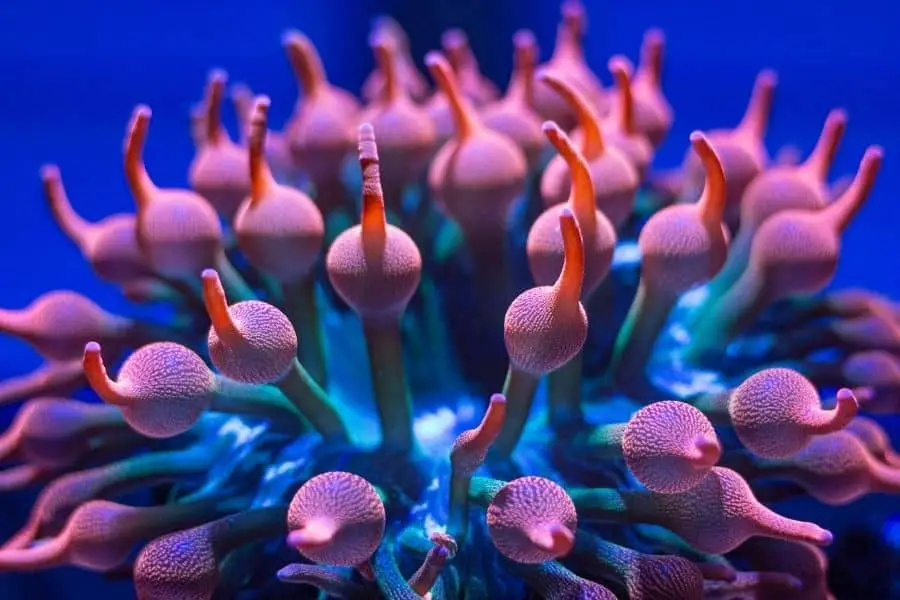
They are fine color combinations of orange and green bubble tip anemones. As same as other Anemones, they make outstanding hosts for ClownFish. These anemones are roughly 3.5-4 inches in diameter.
Black Widow Bubble Tip Anemone
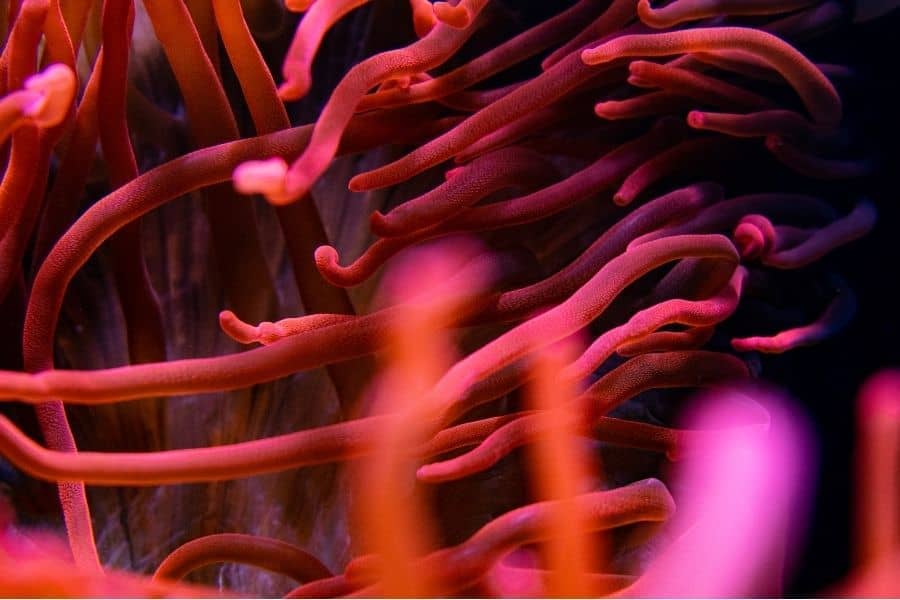
They are bold metallic in color. They have bright webbing and deep red color foot. Splashes of white snowflake-like patterns can be seen in the body. When propagating them maintain water parameters in good condition by regular or partial water changes. They like a good amount of water flow within the tank. This can be created using pumps and powerheads. These pumps need fairly low maintenance, and they can add a neat look to your tank.
Tank requirements
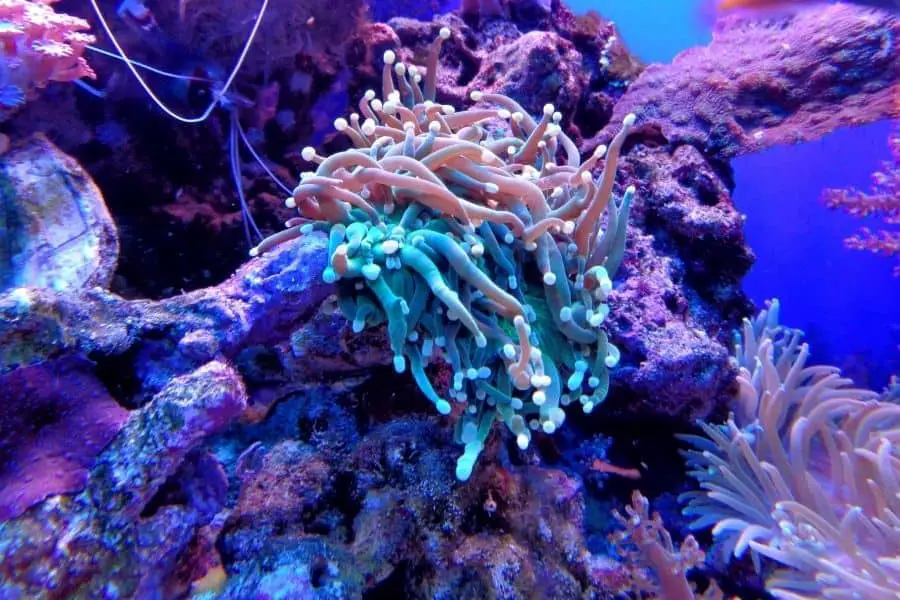
The tank requires special criteria and conditions for the bubble tip anemone to survive. Water in the tank is a critical factor when raring them. The reason is anemones love to enjoy the good conditions of the water.
Size of the tank
The minimum tank size suitable to propagate is a 30-gallon tank. The tank size depends on the type of anemone that is going to propagate. Under ideal conditions, these anemones can grow up to 12 inches in diameter.
required Water quality
Salinity level
High water quality conditions should prevail inside the tank. When you measure the salinity using a Hydrometer, measurement comes as specific gravity. The salinity of the water should be between 1.023 – 1.025 (specific gravity).
Water temperature
The temperature should be between 25°C – 28°C (77° F -82.4 °F). You can install an aquarium heater to maintain the temperature at a stable level.
the pH of the water
The pH of the water should be between 8.1 and 8.4. Use a digital pH meter to measure the pH.
Water Hardness
Alkalinity should be maintained between 8-12 (mg/L). There should not be dissolved ammonia and nitrite in tank water. You should maintain low amounts of iodine, phosphate, and nitrate in tank water. These conditions encourage the healthy growth of the blue tip anemones. Maintain water parameters to favorable levels by regular, partial water exchange. Anemones like a good amount of water flow within the tank created with pumps and powerheads.
The flow rate of the water
Regular and partial water changes will help to maintain water parameters in good conditions. They prefer a good amount of water flow within the tank. This can be created by using pumps and powerheads.
Lighting in the tank
Anemones need plenty of light. It helps them to get the energy to make their food. Foods promote the growth of the anemones. In another way, light improves their skin color. Therefore, light requirements should be a high priority in this regard. Anemones need moderate to high light intensity to grow well. The tank will therefore need bulbs, Metal halides, T5 fluorescent bulbs, 14-20K color spectrum to produce the necessary amount of light.
How to place a bubble tip anemone in a tank
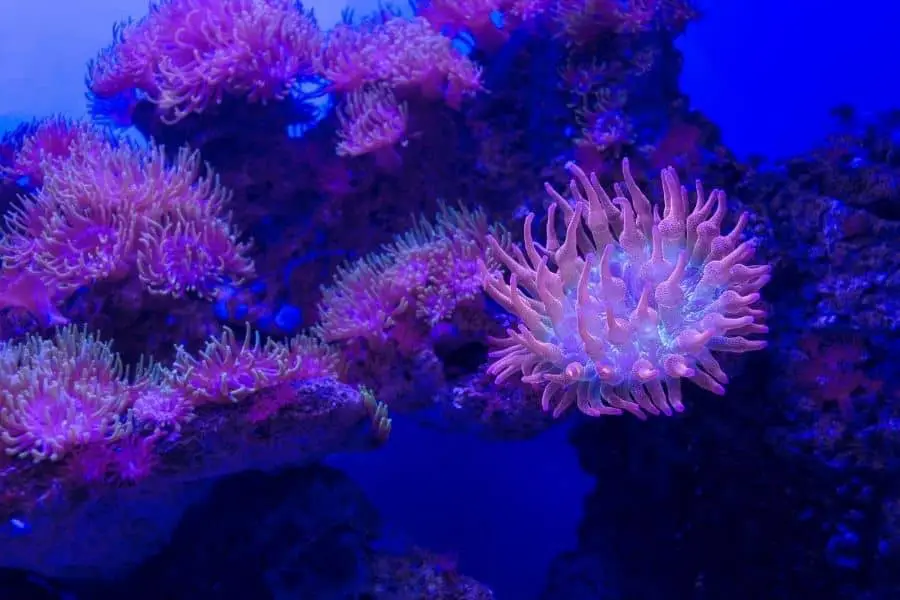
Bubble tip anemones are quite mobile. They move in the direction of lightning and water flow into your tank. Therefore, do not expect them to stay still in the tank. They will attach to any glass, rock, or solid surface in the tank.
- Be mindful to protect pump intakes and overflows from anemones in case of getting sucked up.
- Be mindful to maintain a good flow of water inside the tank. When placing anemones inside the tank, the flow should be turned down. Water flow can be increased after attaching anemones to a rock.
- Maintain a space of 3 or 5cm in between the anemone and the corals.
- When the anemone attaches to an unwanted place, direct a water flow towards the anemone. Then it may reattach somewhere suitable.
- Remember to minimize the handling as much as possible.
- A healthy anemone tank placement is mostly dependent on more knowledge of the aquarist.
- Get a care guide to learn more about the procedure of healthy placement of an anemone.
How to frag/propagate them
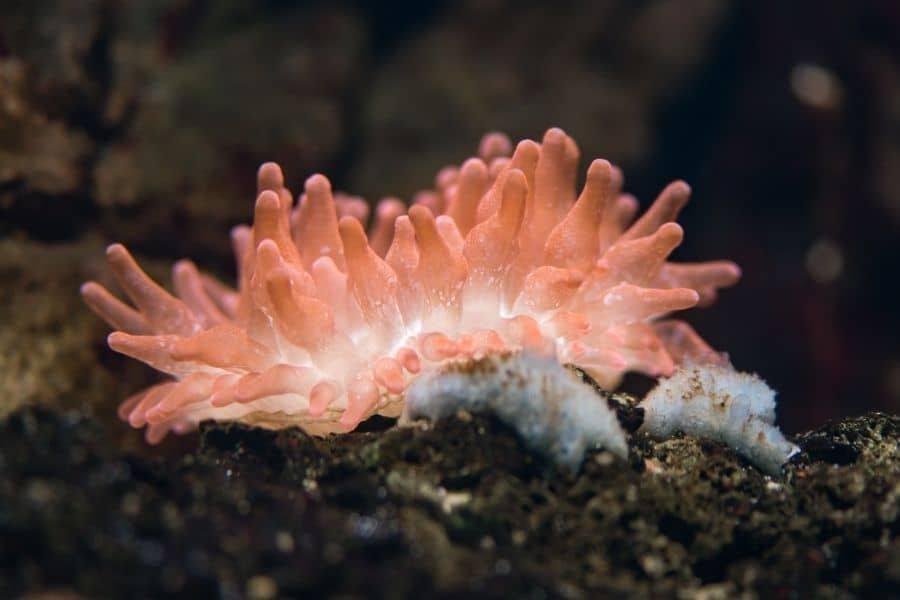
They are amazing creatures when it comes to reproduction. Depending on the exact species, they can reproduce either sexually or asexually. Asexual reproduction methods use to propagate anemones are budding, fragmentation and fission. Farmers identify “fragmentation” more commonly as “splitting “. This is the most popular method of propagating anemones in captivity. Propagating Anemones is easy. Simply cut them equally into two halves. The most challenging step is husbandry and raising them to a healthy size. When they grow up, cut again and continue the propagating cycle.
- Cutting anemones with a razor blade or scalpel is less stressful than the natural binary fission process that occurs in the ocean.
- Use large hydroponic trays to propagate the anemones.
- The shallow trays are ideal for this purpose. The reason is that these trays have a large available surface area and minimal water volume.
- The smooth surfaces allow you to remove the Bubble Tips easily that are attached to the tray.
- Fill the tray with recommended biological filter media. It provides Biological filtration and a substrate for the anemones to attach to.
- Rubble rock or crushed coral can also be used as substrates.
How fast do bubble tips anemone grow?
Their growth is dependent on several factors. They include mainly how much you feed it, light availability and the water quality conditions of the tank. If these factors are at favorable levels a sudden growth can be achieved. Normally, 4 inches of growth rate can be achieved in anemones within 2 months. But all the factors should be kept within favorable levels. Simplify if you did not feed them properly anemones would not be grown as fast.
What do bubble tips anemone eat?
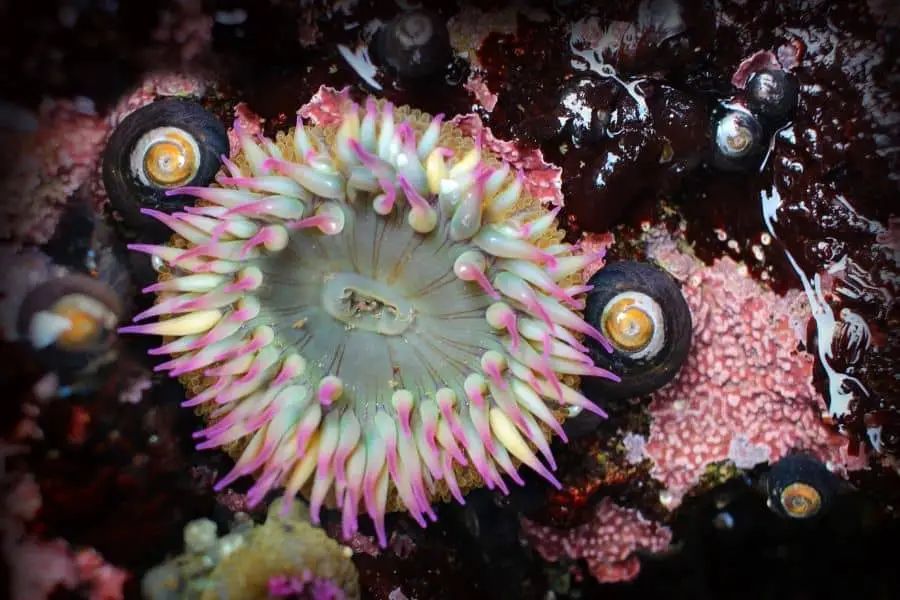
How to feed
They need a protein-rich diet. Food enhances their coloration. Therefore, protein-rich seafood such as squid, shrimp, clams, and mussels are ideal for anemones. Before feeding, bring the food to the same temperature as the tank water. First, wash your hands to remove any soap or moisturizer. Make sure traces in your hand do not contaminate the food or tank water. Cut the food into pieces.
The sizes should be in relation to the mouth sizes of the anemones. Quarter-inch pieces are suitable for smaller anemones. But larger pieces are needed for large anemones in case they can digest them. Use a feeding stick or tank tongs to give them food. Hands also can be used to give food but there is a risk of being stung. Slowly place food on the tentacles of the anemone. They should grasp food and move it towards and into the mouth. Do not throw the food toward the anemone.
Feeding frequency
Feeding frequency means the rate at which feeding occurs over a particular period. Normally feeding frequency of anemones is about one to three times a week. But this depends on the size of the fish and the nutrition amount of the diet. When there is a clownfish in the tank feeding frequency can be reduced. The reason for this is the clownfish helps anemones to catch their prey. Therefore, no need to feed them again and again.
What should you do After feeding
Bubble tip anemones do not like some food that we give. Sometimes they may spit out these foods. On such occasions, they may excrete it as a mucus-like cocoon and hold it with tentacles to eat later. These foods may be deposited in the tank. Remove such uneaten food after an hour. Otherwise, rotten food can pollute the tank and cause significant water quality problems.
Bubble tip anemone and clown fish
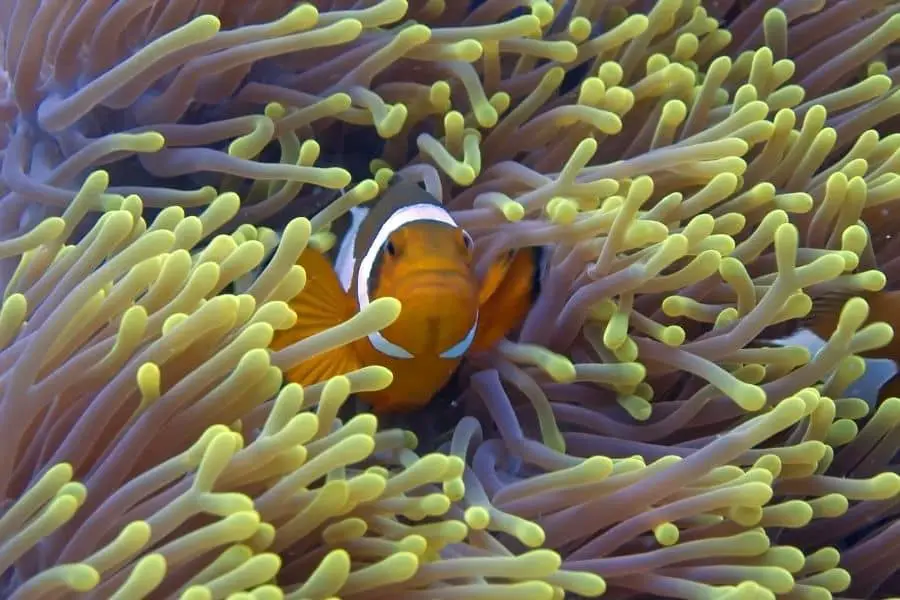
In natural environments, bubble tip anemones and clown fish have a symbiotic relationship. That means they help each other as good friends. This is how it happens. The anemone alone is prone to natural predators. larger fish try to attack the anemone and tear their tentacles. However, when anemone pairs up with clown fish they take care of each other.
Bubble tip anemone provides clown fish a hiding place and clown fish bring food to the anemone. If you have either bubble tip anemone or clownfish alone in your tank, try and introduce the other into the tank. You definitely see how they pair up easily and become friends.
Predators of bubble tips anemone
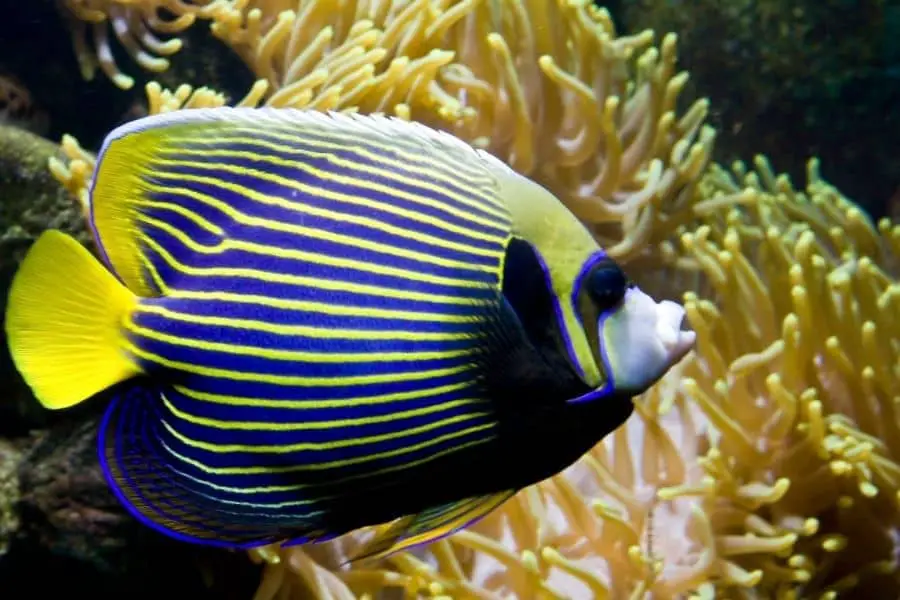
Predators are the animals that hunt or prey on other animals. Angelfish can be considered the most common predator in Bubble tip anemones. Angelfish will feed on the tentacles of the Bubble tips anemones. Other predators are more venomous anemones, some marine mollusks, and some species of sea stars. But Clownfish can protect the Bubble Tip Anemones from Angelfish and other predators.
Why are bubble tip anemone dying?
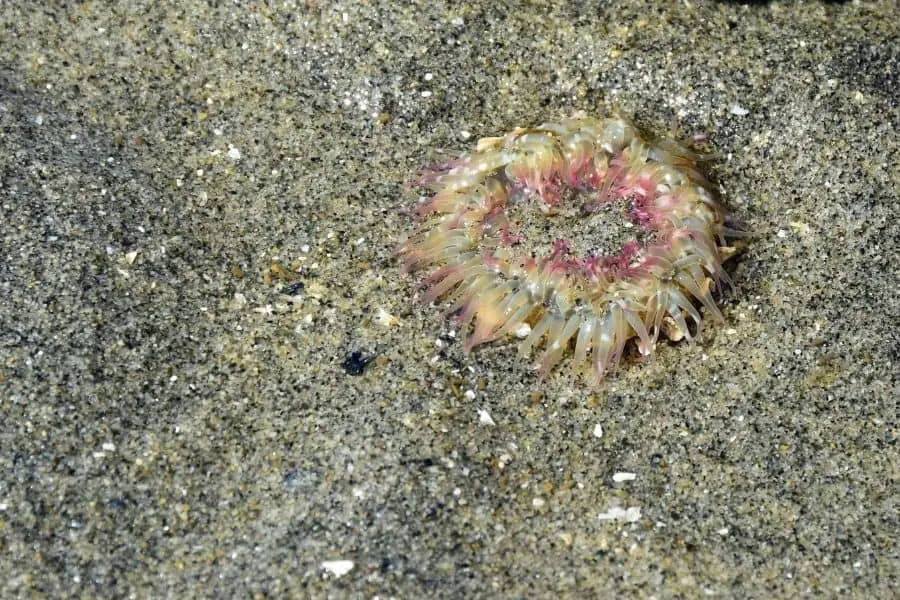
Bubble tips anemones can live long. But the exact or the appropriate age of them is not discovered yet. The combination of low salinity, stress, improper lighting, and poor water quality conditions are not favorable factors for the growth of the Bubble tips anemones. These factors even can contribute to shortening their life expectancy.
When the temperature is very high in the environment, Bubble tips anemones undergo a process called “bleaching”. Bleaching destroys the edible algae in the tank too. The internal food supply of the bubble tip animals will lose as a result. This converts the anemone into white. The reduction of health in Bubble tips anemones can drive them to death.
Related topics
Are bubble tips anemone poisonous to us?
Not that much, But Bubble tip anemones can sting you. They have stinging cells called “nematocysts”. Stinging cells pierce our hand as soon as we touch the body of an anemone. These stinging cells are more poisonous to fish and threaten their lives. But for humans, it usually goes unnoticed. In some instances, it just appears as sticking to us. It becomes alright after some time.
Do bubble tips anemone overspread?
Bubble tip anemones are one of the easiest anemones to keep. They can propagate easily. But the factors like water quality, lightning and feeding decide the growth rate. Within 6 months the anemone can grow up to 4 inches. Therefore, bubble tip anemone shows a moderate growth rate. So, we can not say that as overspread.
Why do bubble tip anemones lose their bubbles?
Sometimes the bubbles of the bubble tip anemones may lose or disappear. There is not an exact reason for this. But some causes may be responsible. When the anemone receives insufficient sunlight, feeding and poor water quality conditions the bubbles may lose in bubble tip anemones.
In another aspect when there is a predator or a competitor living with the bubble tip anemone it may also be responsible for the loss of their bubbles. It was found that when the clownfish aggressively host the anemone it also can disappear bubbles. With that, we can conclude Bubble tip anemones tend to lose their bubbles when a threat exists to them. When we remove the threat factor the bubbles may develop again in bubble tip anemones.
Can you touch the bubble tip anemone?
Yes, when we touch a bubble tip anemone it may sting. But it is not severe for humans. Most people do not feel it or react. Only some sensitive people may react to the sting. But that is also not severe at all. Therefore, it is better to wear a pair of gloves. Powerless rubber gloves or Nitrile gloves are good to wear when handling bubble tip anemones.
Can bubble-tip anemone kill fish?
Yes, Bubble tip anemones are carnivorous. That means they eat only the flesh of the other animals. They can kill certain types of smaller fish by stinging them up to death. Bubble tip anemones mostly kill fish babies and the weak bottom-dwelling fish. But cardinalfish and damselfish can live peacefully with bubble tip anemones in captivity. Altogether the only species that can get true benefits from bubble tip anemone are the clownfish. Bubble tip anemones provide protection and shelter for the clownfish.
Read More : Green Star Polyps (Pachyclavularia violacea) Coral Grow And Care Guide
